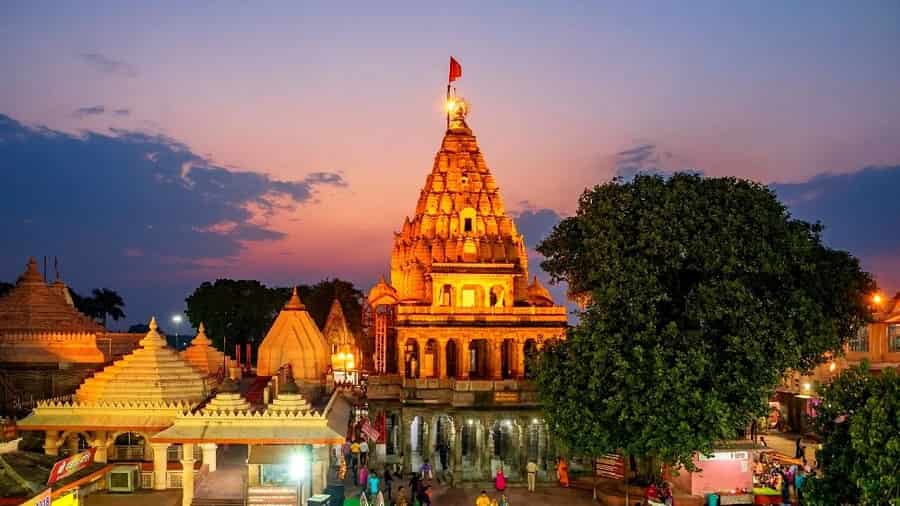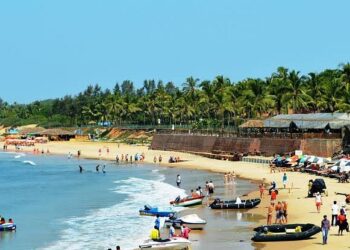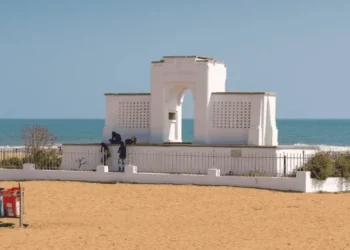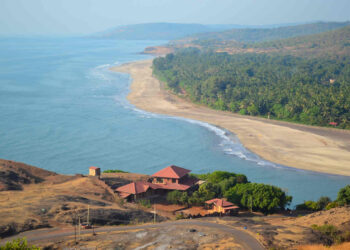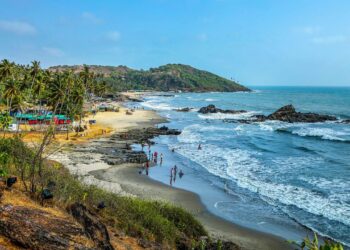Mahakaleshwar Jyotirlinga Temple, stands by the quiet banks of the Shipra River in Ujjain, Madhya Pradesh, dedicated to Lord Shiva, one of twelve holy Jyotirlingas, shrines which are said to be the most sacred abodes of Shiva. Built in the 6th century, the temple holds the shiva linga known to be in the form of dakshinamurthi, which means that it is facing the south.
Notable Fact: The temple’s Bhasm Aarti, where ash is offered to the linga, is a rare sight, found nowhere else.
Mythological Significance
Mahakaleshwar holds ancient tales from the Shiv Mahapuran. According to the Shiv Mahapuraan, Brahma (the Creator) and Vishnu (the Preserver) once had a disagreement about which of them were supreme. To test them, Shiva pierced the three worlds as an immeasurable pillar of light, the Jyotirlinga. Vishnu and Brahma parted company to determine the extent of each end of the pillar. Brahma, who had set off upward, lied that he had discovered the upper end of the pillar, but Vishnu, who had gone in the direction of the base of the pillar, admitted that he had not. Shiva then appeared as a second Jyotirlinga and cursed Brahma, telling him that he would have no place in the ceremonies. The Jyotirlinga is the supreme indivisible reality from which Shiva appears. Jyothirlinga shrines commemorate this time when Shiva appeared. It was believed that there were originally sixty-four jyotirlingas. Twelve are considered to be especially auspicious and holy. Each of the twelve sites takes the name of the presiding deity and each is considered a separate manifestation of Shiva. At all these sites, the primary deity is a lingam representing the beginning less and endless Stambha pillar, symbolizing the Shiva’s infinite nature. Another tale says demon Dushana harmed Ujjain’s sages, till Shiva rose to crush him. Devotees say prayers here chase fear and bring lasting peace.
Historical Background
The current temple’s history is traced back to the 6th century, built by Gupta lords. Ujjain was a city of faith and learning. It was called Avantika and was famous for its beauty and its status as a devotional epicenter. It was also one of the primary cities where students went to study holy scriptures. Islamic raiders broke it in the 13th century. The Jyotirlinga was dismantled and believed to be thrown into a nearby ‘Kotiteerth Kunda’ (a pond neighbouring the temple) with the Jaladhari (a structure supporting the Lingam) stolen during the invasion. It was later reconstructed and revived by Maratha Diwan Ramachandra Baba Sukthankar. It was again attacked by Jalaluddin Khilji and Alauddin Khilji.
Architecture of Mahakaleshwar Jyotirlinga Temple
Mahakaleshwar Temple sits on two acres by the Shipra, made in Nagara style. The main part has a five-story top, carved with Shiva’s trident, snakes, and lotus blooms, all in dark stone. Inside, the Mahakal linga, black and facing south, sits in a silver pit, lit by ghee lamps. The inner walls got plain stone with old prayers.
The temple has five levels, one of which is underground. The temple itself is located in a spacious courtyard surrounded by massive walls near a lake. The shikhar or the spire is adorned with sculptural finery. Brass lamps light the way to the underground sanctum. It is believed that prasada (holy offering) offered here to the deity can be re-offered unlike all other shrines.
A small hall has twelve pillars, carved with gods and wise men. Small shrines for Parvati, Ganesh, and Kartikeya stand in the yard, made of stone. The Parvati shrine shows her sitting, for calm. The Ganesh one, from 1200, has him with sweets, for smarts. The Kartikeya one shows a peacock, for might. The stone yard feels holy, near the river. A tall gate has Shiva’s shape. A water tank, Rudrasagar, has rough steps for ritual dips. Pillars tell Shiva’s stories, guiding those who pray. The river’s flow adds peace.
Rituals and Festivals
Maha Shivratri, in February, is biggest festival, with all-night chants and milk pujas. Shravan, in July or August, brings daily linga baths with water. Diwali, in October or November, lights lamps for joy. Kartik Purnima, in November, pulls pilgrims for Shipra dips. Nag Panchami honors Shiva’s snakes.
Each day starts with Bhasm Aarti at 4:00 AM, offering ash, a sight to see. Abhishekam at 7:00 AM uses milk. Evening aarti at 7:00 PM has lamps. Special prayers, like Rudrabhishek, cost ₹100–500 and give blessings. A stall hands out free tilak for prasad. Mondays, people bring bilva leaves for strength and peace.
Information for Travelers
Hours and Entry: Open every day, 4:00 AM to 11:00 PM. It’s free to enter, but prayers cost ₹100–500. No pictures in the inner room. Book Bhasm Aarti ahead.
Clothing: Wear clothes covering shoulders and knees. Women for prayers wear sarees or suits, men wear dhotis.
How to Get There:
Air: Indore Airport, 55 km off, is closest. Taxis take 1 hour, cost ₹1200–2000.
Train: Ujjain Station, 1 km away, links to Bhopal (3 hours). Autos cost ₹50–100.
Road: Buses from Indore (1 hour) come to Ujjain. Taxis cost ₹800–1200. Roads are quiet.
Best Time to Visit: October to March is cool, 20–30°C. Weekdays are calm. Maha Shivratri’s full, so plan early.
Nearby Attractions:
Kal Bhairav Temple, 6 km away, offers liquor as prasad.
Harsiddhi Temple, 2 km away, is a Shakti Peetha.
Ram Ghat, 1 km away, is a Shipra bath spot.
Sandipani Ashram, 5 km away, was Krishna’s school.
Mangalnath Temple, 7 km away, honors Mars.
Final Thoughts
Mahakaleshwar Jyotirlinga Temple in Ujjain, Madhya Pradesh, a sacred place in India’s heart, is a treasure for the soul. Lord Shiva’s divine touch fills all who come, making it a spot you must see among India’s holy sites.
